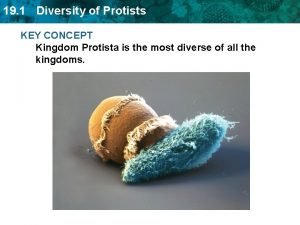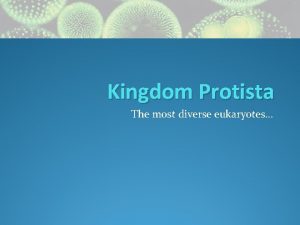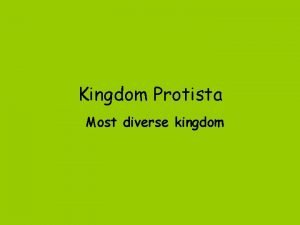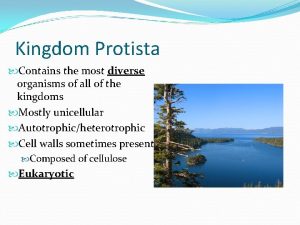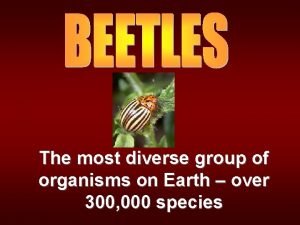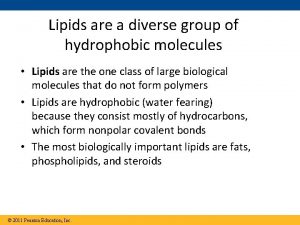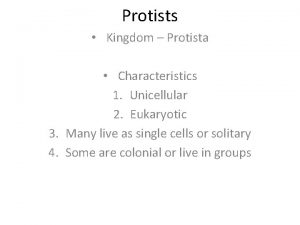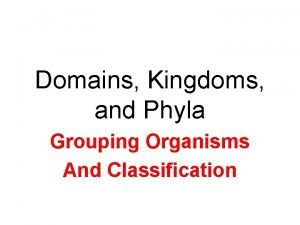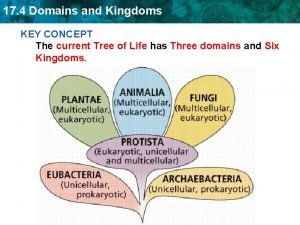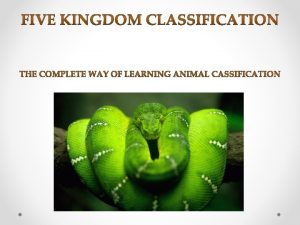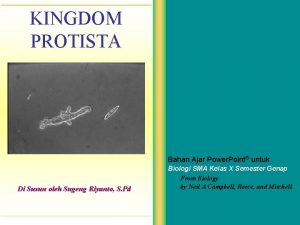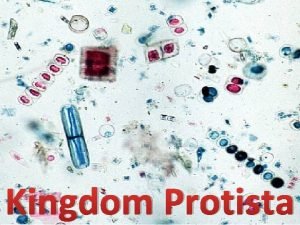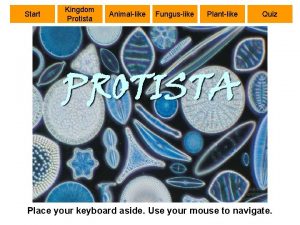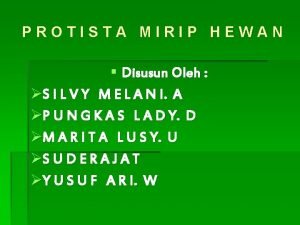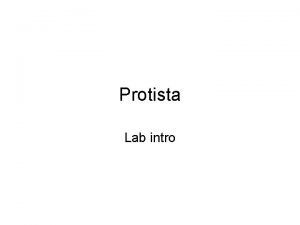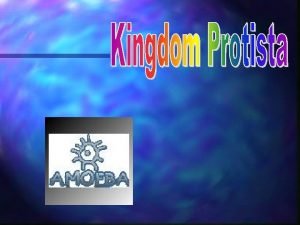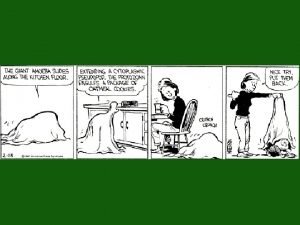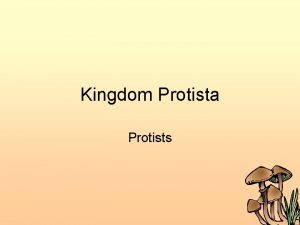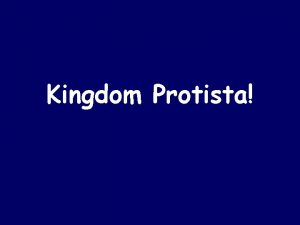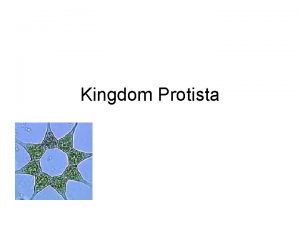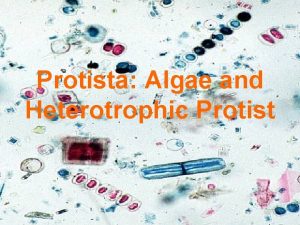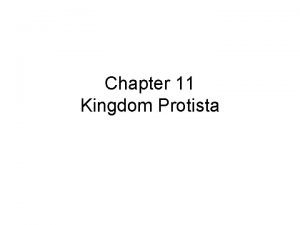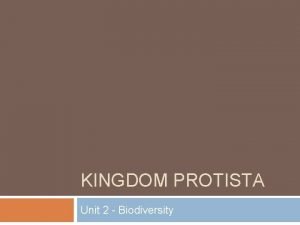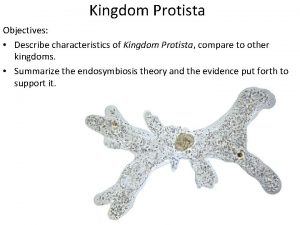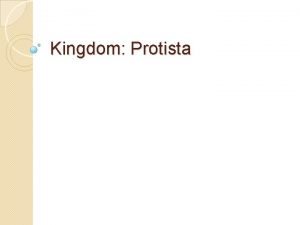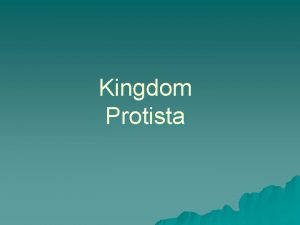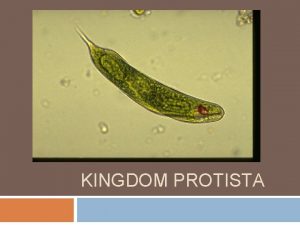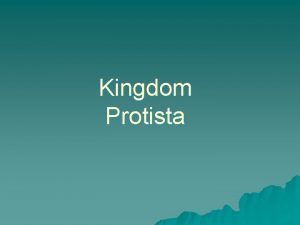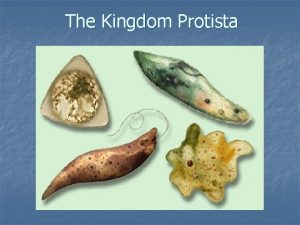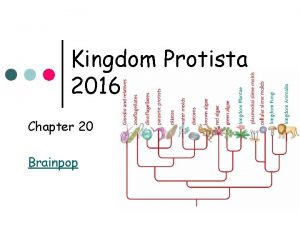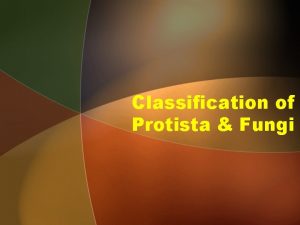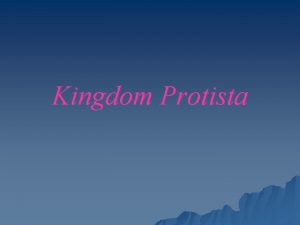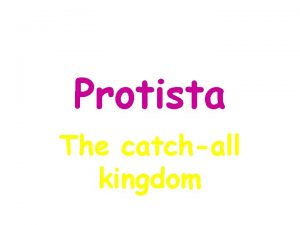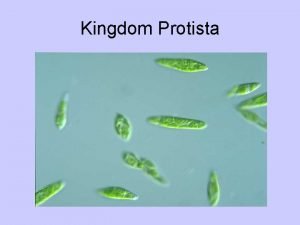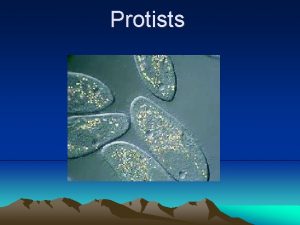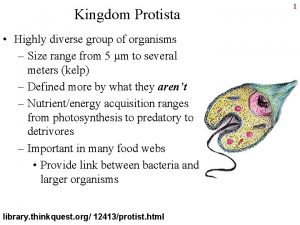Kingdom Protista Kingdom Protista Very diverse group of






























- Slides: 30

Kingdom Protista

Kingdom Protista • • • Very diverse group of organisms Hard to classify Some are heterotrophs Some are autotrophs Most unicellular, some multicellular ALL are EUKARYOTES – Have a nucleus – Have membrane bound organelles

Kingdom Protista • There are three main groups: Animal-like ( Protozoa) Plant-like ( Algae) Fungus-like

Animal-like Protists • Unicellular heterotrophs • Are classified by the way they move – Sarcodines ( rhizopods) – Ciliates – Zooflagellates – Sporozoans

Zooflagellates Move with flagella—whiplike structures

Zooflagellates • 1, 2, or many flagella • Absorb food or can be parasites • Reproduce asexually by binary fission

Zooflagellates Trypanosoma *causes African sleeping sickness * carried by the tsetse fly

Zooflagellates Trychonympha( mutualistic) and lives in the guts of termites and helps them digest wood

Sarcodines • Move with pseudopodia – Pseudopodia means “ false feet” and are extensions of the cytoplasm – Movement is called amoeboid movement – Can also be used in phagocytosis( getting food) – Reproduce by binary fission

Sarcodines • Amoeba • Heliozoans • Radiolarians

Ciliates • Move by cilia—tiny hairlike projections off the cell membrane – Cilia can also be used for feeding – Can be found in fresh and salt water – Can have two nuclei – Contractile vacuole—help pump extra water out—remember osmotic balance? ? ?

Ciliates Paramecium

Ciliates Stentor

Sporozoans • Not able to move( no movement ) • Are parasitic • Reproduce by producing spores – spores are haploid reproductive cells

Sporozoans Plasmodium • Transmitted by mosquitoes • Causes the disease Malaria

Plant-like Protists • • Also called Algae Classified by color and structure Are autotrophs Most unicellular, some multicellular

Euglenophyta • • • Common name: euglenoids Pigments: chlorophyll ( green ) Unicellular Have eyespot and pellicle Autotroph most of the time, can be a heterotroph • Moves with a flagella

Euglena

Pyrrophyta • • • Common name—dinoflagellates “Fire Algae” Unicellular Can live in fresh and marine water Are bioluminescent Some cause algal blooms and “red tide”

Pyrrophyta Gymnodinium can cause red tide The algae release toxins that poison and kill fish and shell fish and is a problem for the enviroment.

Chrysophyta • Common name— • Asterionella “golden algae” • Pigments—yellowgreen to golden brown • Unicellular • Cell walls made of pectin

Bacillariophyta • Common name— Diatoms • Unicellular • Cells walls made of silica—can be used to make toothpaste and cosmetics • Two cell walls fit together ( like a petri dish)

Rhodophyta • • Common name— “red algae” Pigments—phycobilins, chlorophyll a Multicellular Used to make agar—used in ice creams and puddings as a thickener

Rhodophyta • Coralline Algae • Irish Moss

Phaeophyta • • • Common name— “ brown algae” Pigments—fucoxanthin, chlorophyll a & c Multicellular Largest and most complex of all algae Uses—iodine, food, and algin ( in some food products )

Phaeophyta • Fucus • Lamanaria

Phaeophyta • Sargassum • Rockweed

Chlorophyta • • • Common name— “ green algae” Pigments—chlorophyll a & b Multicellular Has cellulose in cell walls Can live in fresh or salt water Believed to be the ancestors of the Plant Kingdom

Chlorophyta • Volvox • Spirogyra • Ulva( sea lettuce) • Chlamydomonas

Fungus-like Protists • • • Heterotrophic Decomposers Two types: 1) Slime Molds 2) Water and Downy Molds
 Cellular vs plasmodial slime molds
Cellular vs plasmodial slime molds Chrysophyta
Chrysophyta What is the most diverse kingdom
What is the most diverse kingdom Sexual reproduction
Sexual reproduction Old kingdom middle kingdom new kingdom
Old kingdom middle kingdom new kingdom Old kingdom middle kingdom new kingdom
Old kingdom middle kingdom new kingdom Youtube
Youtube Mentohotep
Mentohotep Most diverse group of organisms
Most diverse group of organisms It is diverse group of hydrophobic molecules
It is diverse group of hydrophobic molecules Very bad to very good scale
Very bad to very good scale Scientific notation rules
Scientific notation rules Fewfewfewf
Fewfewfewf Receiving table/area
Receiving table/area A little food or a few food
A little food or a few food Kingdom protista characteristics
Kingdom protista characteristics Are protists eukaryotic
Are protists eukaryotic Kingdom protista
Kingdom protista Eubacteria examples with scientific names
Eubacteria examples with scientific names Chapter 17 domains and kingdoms concept mapping answers
Chapter 17 domains and kingdoms concept mapping answers Kingdom protista classification chart
Kingdom protista classification chart Protista, fungi, plantae, animalia *
Protista, fungi, plantae, animalia * Ppt protista kelas 10
Ppt protista kelas 10 Domain eukarya kingdom plantae
Domain eukarya kingdom plantae Nutrition in protists
Nutrition in protists Quiz 3: plant- and fungus-like protists
Quiz 3: plant- and fungus-like protists Dinoflagellates characteristics
Dinoflagellates characteristics Kingdom protista multicellular unicellular
Kingdom protista multicellular unicellular Kingdom protista habitat
Kingdom protista habitat Kingdom plantae prokaryotic or eukaryotic
Kingdom plantae prokaryotic or eukaryotic Protophyta characteristics
Protophyta characteristics
